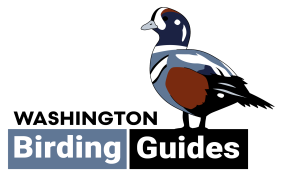FAQ
Band-tailed Pigeon © Liam Hutcheson
ANSWERS TO your QUESTIONS
Planning a birding trip can have a lot of factors to consider and some unknown variables. This guide to frequently asked questions will help you with the process. Please ask us if you need further clarification on any of these points or if your question isn’t here.
Where do I go?
Washington is a large state with a wide variety of ecosystems and habitats. Each region hosts its own suite of specialty birds, often featuring multiple species that aren’t readily found elsewhere in the state. Take a look at our locations page to get an idea of which regions are home to which species. Consider your birding objectives, how much you want to travel, and your budget. If the sky is the limit, perhaps a tour that takes you from southeast to southwest and then wraps up north is the way to go!


When do I come?
Birding in Washington is great year-round, though different seasons have their own attractions. With a wide variety of habitats, from the Pacific Ocean through the Cascades to the sagebrush steppe of the east, each region shines at different times. Coastal Washington is at its best in the cooler months when the waters are teeming with migrants from up north. The mountains are ideal in the summer, when resident birds are breeding and migrants have returned. Many of the steppe specialties can be found year-round, but the best time to visit is in late spring, when breeding activity peaks for both resident birds and migrants.
What will I see?
This depends on when you come, where you go, and your objectives. Washington Ornithological Society produces a useful up-to-date state checklist and while eBird is without doubt the most dynamic tool available. Use the downloadable lists to determine which species you can expect to see or target during your visit. You can view species sorted by taxonomic order (evolutionary relationships) or sighting frequency (percentage of checklists that have reported the species). NOTE: frequency does not necessarily reflect the likelihood of seeing a given species.
TAXONOMIC Order
Sighting FREQUency
What do I bring?
Start with whatever you bring out birding on a regular basis – binoculars, spotting scope, camera, appropriate outerwear (including sunscreen, bug spray, and chapstick), daypack, and water/snacks. Check out our services page for a list of what we’ll bring along as well. Bring at least one layer each of clothes for warm, cold, and wet conditions, and be sure to check with your guide to see if more layers make sense based on the location or weather conditions. We recommend sticking with long pants, long sleeves, and closed-toed shoes when in the field.


What do I eat?
Food is handled according to circumstances and preferences. Breakfast is quick, usually at your lodging, a fast restaurant, or packed ahead of time for the field. Similarly, lunch is often on-the-go, either packed or ordered at a quick restaurant along the way. Many people choose to beat the heat and the mid-day lull by taking a break and enjoying lunch at a dine-in restaurant. Dinner is the best time to relax and enjoy some good food out. If you’re in season, don’t miss out on the local cherries and apples. For beverages, you can’t go wrong with any of the state’s numerous local breweries. Yelp and TripAdvisor are excellent resources to locate Washington’s non-bird specialties!
What is the weather like?
Washington’s climate varies seasonally and regionally. The coast has fairly moderate weather year-round and is quite rainy, especially around the Salish Sea. The mountains experience snowy winters and beautiful, warm summers. Eastern Washington has warm, dry summers and cold, snowy winters. Of course, weather is always changing, so it is best to check the conditions for your specific location before you go. Accuweather and Weather Underground are excellent resources.


